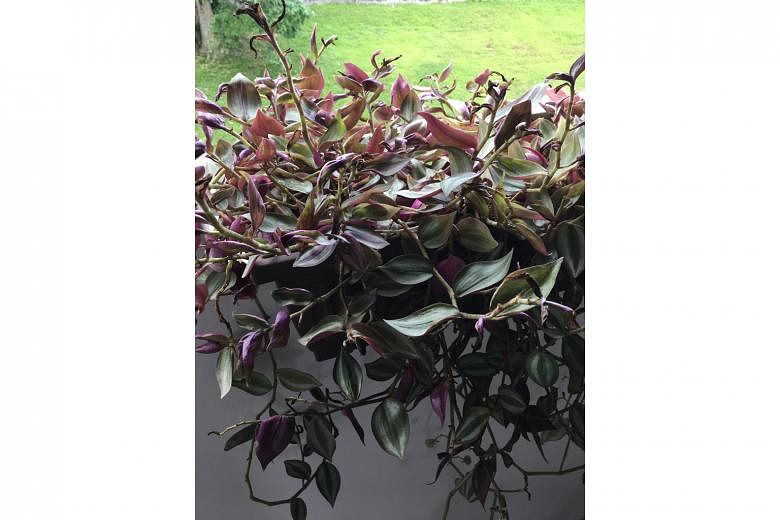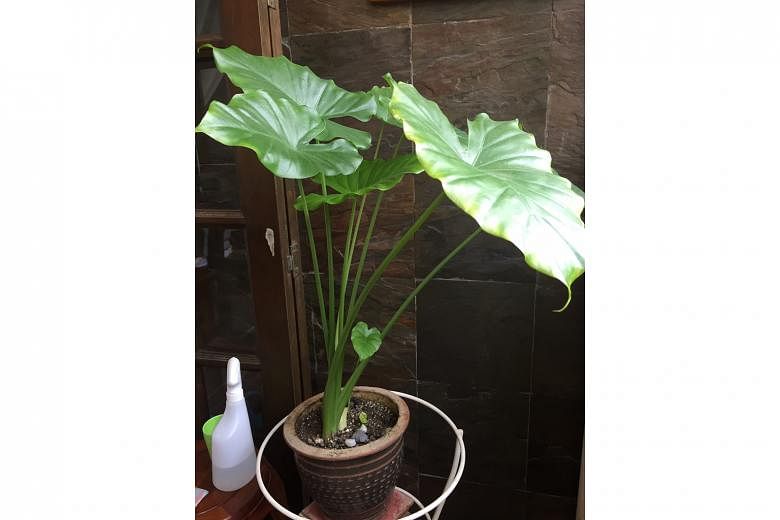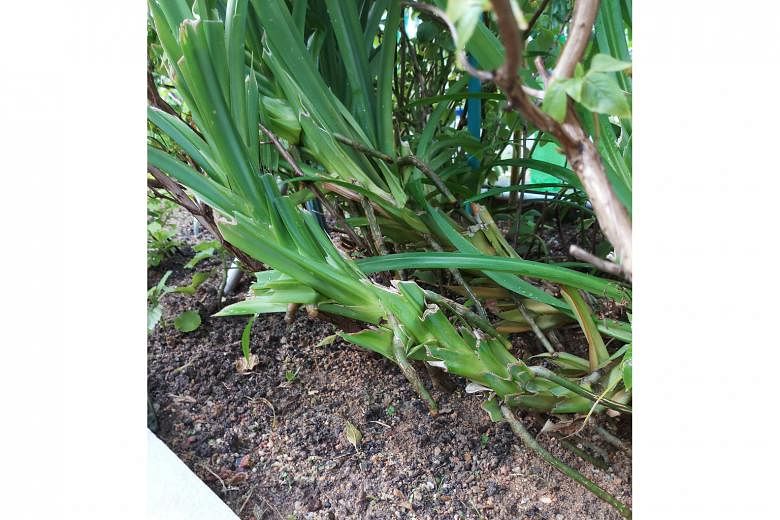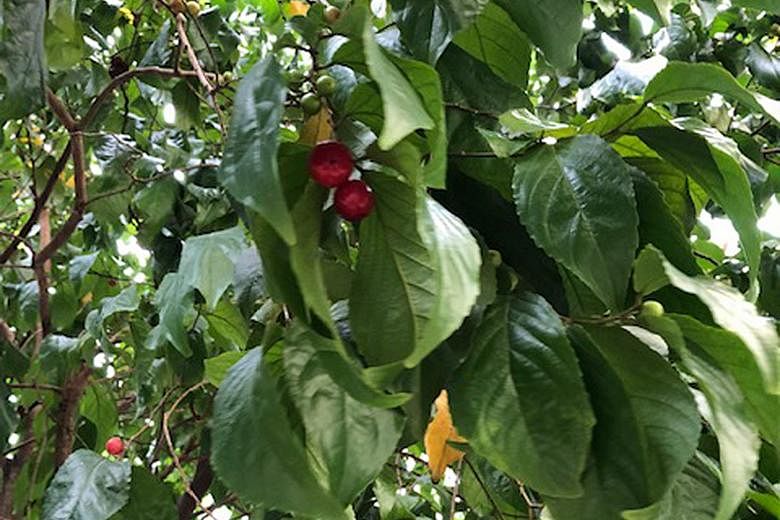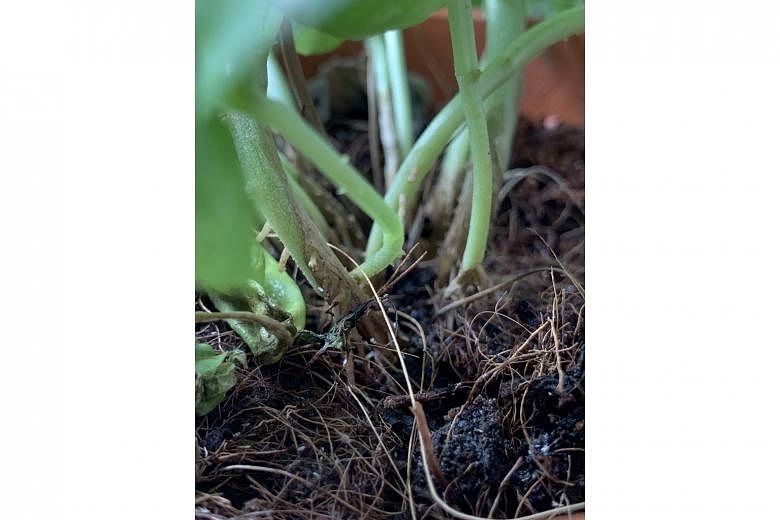Silver Inch Plant is sunburnt
Why is my creeper plant drying out at the ends? The colour of its leaves is not as vibrant now. I hang the planter box on the balcony and the plant is exposed to sunlight in the morning, till mid-morning. Is it due to exposure to too much sunlight? How can I better take care of this plant? What is its name?
Lilian Tan
The botanical name of your plant is Tradescantia zebrina and its common names include Silver Inch Plant and Wandering Jew.
It thrives under semi-shaded conditions with filtered sunlight for at least four hours daily. The burnt new growth, as well as leaves that are bleached, could be signs that the plant is receiving too much light. You may want to move it to a less sunny site.
However, the damaged portions of the plant will not recover.
For now, prune away the damaged portions so that new growth will take over and reduce the likelihood of disease.
Giant Elephant Ear needs direct sunlight
I have had this plant for almost two years. The stalk is tall and tends to bend in one direction. I repotted it once and noticed the roots are like those of yam.
Can I submerge the roots deep in the soil? Why do the leaves turn yellow sometimes and the stalk become weak? Do I have to move it to a bigger pot as the stalk is getting taller?
Doris Tan
The plant you have is commonly known as the Giant Elephant Ear and its botanical name is Alocasia macrorrhizos.
Under low light, plants will produce elongated and floppy growth that is prone to pest attack and mechanical damage.
In an apartment, it is best to place it by the window or along the corridor where it can get direct sunlight for at least four hours daily.
The plant tilts in one direction because it is reaching towards light. You can rotate the pot periodically to achieve a more symmetrical growth habit.
This plant can grow quite big and confining it in a small pot will restrict its growth, keeping the plant small in the short term.
However, the plant's roots will quickly fill the pot and you will need to water it regularly to keep it healthy.
Finally, when potting the plant, ensure the soil does not cover its crown as this can cause the plant's base to rot and lead to death.
Use a stake to provide support for the plant instead of burying the plant too deeply, which is a common mistake people make when repotting.
New growth in pandan plant will occur when plant is pruned correctly
My pandan plant is growing and slanting towards the ground. Is this because of the weight? If I chop off the top portion, will new leaves appear and is the plant able to survive?
Janice Toon
The pandan plant will generally produce new shoots when it is pruned and it is important to know where to cut the plant.
The portion of stem that will most likely produce new shoots is where it is still green.
Older parts of the stem which are found lower down along the stem, nearer to the roots, may not produce new growth if the plant is pruned to that portion.
Fruit of Thornless Rukam can be used to make pies, jellies
This tree is found along walking paths in Tampines, and is laden with berries. Are these berries edible?
Fareda Sultana A. A. Bawany
The tree in your photo is botanically known as Flacourtia inermis and its common names include Lobi-lobi, Plum of Martinique and Thornless Rukam.
This tree species is widely planted along Singapore's streets as well as in parks and gardens for its attractive pinkish-to-red young foliage.
The leaves are also food for caterpillars of the Leopard and Rustic butterflies. This makes the plant a feature in butterfly gardens.
The ripe fruit of this tree is edible, but is not consumed raw and not popular with birds due to its sour and astringent taste.
The fruit can be used to make pies, syrups and jellies.
Springtails are harmless to humans and plants
My basil plant seems to have some white bugs crawling around. What are they and are they a cause for concern?
Lois Lek
The tiny white critters that are found in the pot of basil could be springtails.
They play an important role in nutrient cycling and maintaining soil health, which are vital for the growth of plants.
Springtails are found usually in places rich in organic matter and with high moisture.
In large numbers, springtails are merely a nuisance. They are harmless to humans as they do not bite. They also do not damage plants.
Allowing your soil to dry out a little between each watering can be a simple way to manage the population of springtails in your pot of basil.
Another possibility could be root mealybugs. These are pests which appear as white cottony masses in the roots and suck sap from there, weakening the plant over time.
Organic remedies do not usually work on root mealybugs - a chemical-pesticide drench can be used to treat the infestation.
• Answers by Dr Wilson Wong, an NParks-certified practising horticulturist and park manager. He is the founder of Green Culture Singapore and an adjunct assistant professor (Food Science & Technology) at the National University of Singapore.
• Have a gardening query? E-mail it with clear, high-resolution pictures of at least 1MB, if any, and your full name to stlife@sph.com.sg. We reserve the right to edit and reject questions.
